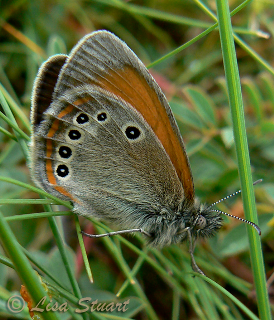Big excitement on Sunday as we set off to confirm a sighting Teresa had around the same time last year of a Spanish festoon in Cillorigo de Liébana.
No sooner had we got out of the car to start our search, and dispel any ideas of April fool's jokes, the first butterfly we saw was in fact Zerynthia rumina! I've seen Spanish festoon before in Andalucia and as far as I'm aware the only other records for the north of Spain have reached to Reinosa in Palencia and Ourense in Galicia.
I managed to grab a distant shot before it left the brambles to fly over the evergreen oaks on the edge of the track.

As we continued our walk around the valley we saw at least five separate individuals of these intricately-coloured butterflies (the Spanish name is Arlequin) and at one point I saw two at the same time. Either among the scrubby undergrowth of Holm oaks or in patches of meadow, where we also found the larval foodplant Aristolochia paucinervis, Spanish festoons are breeding in Cantabria!
Flower-wise the last of the Angel's tears narcissi were still in flower while the first buds of Tassel hyacinths were just opening.
Here's my butterfly list for the day and some more plant and Zerynthia rumina images.
- Spanish festoon, Zerynthia rumina
- Clouded yellow Colias croceus
- Brimstone Gonopteryx rhamni
- Orange tip Anthocharis cardamines
- Green-veined white Artogeia napi
- Green hairstreak Callophrys rubi
- Scarce swallowtail Iphiclides feisthameli
- Weaver's fritillary Clossiana dia
- Speckled wood Pararge aegeria
- Wall brown Lasiommata megera
- Cleopatra Gonopteryx cleopatra
- Mallow skipper Carcharodus alceae
- Large tortoiseshell Nymphalis polychloros
- Peacock Inachis io
- Small copper Lycaena phlaeas



Tassel hyacinth which seems to have changed it's name while I wasn't looking from Muscari comosum to Leopoldia comosa.

A Cantabrian Spanish festoon and it's foodplant, Birthwort Aristolochia paucinervis, below.









